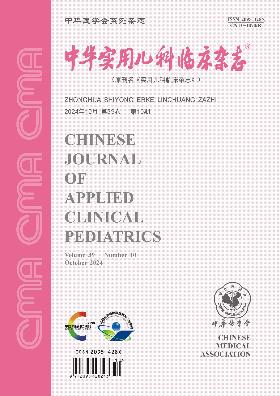BP神经网络在以血尿为主要临床表现的儿童肾脏病理预测中的应用
Q4 Medicine
引用次数: 0
摘要
目的探讨以血尿为主要表现的不同病理类型儿童临床指标的差异,建立基于临床数据的BP神经网络预测模型。方法收集2003年6月至2018年12月转诊至重庆医科大学儿童医院以血尿为主要表现的儿童的临床资料和肾脏病理结果,分析这些临床指标的显著差异,建立了以血尿为主要表现的儿童肾脏病理预测的BP神经网络模型。结果本研究共纳入438例患者,其中男性232例,女性206例,发病年龄为(7.00±3.15)岁。根据临床表现的不同,将患儿分为镜下血尿组(179例)、肉眼血尿组(81例)、镜下血尿蛋白尿组(44例)和肉眼血尿蛋白尿对照组(134例)。不同临床表现的性别比、发病年龄、病程、诱因、Addis尿红细胞计数、24小时蛋白尿、血尿素氮、血清肌酐、血清白蛋白和血清IgA水平差异均有统计学意义(均P<0.05),不同病理组间的家族史、Addis尿红细胞计数、24小时蛋白尿、血尿素氮、血清肌酐、血清白蛋白、血清IgA和C3水平(均P<0.05)。然后基于上述指标构建BP神经网络预测模型,采用漏一法测得预测模型的准确率为61.19%。结论通过比较不同临床表现和病理类型下各项指标的差异,建立了以血尿为主要表现的儿童肾脏病理的BP神经网络预测模型。该模型可以借助相关指标准确预测肾脏病理,为确定肾脏活检时间提供依据。关键词:血尿;肾脏病理学;BP神经网络;预测本文章由计算机程序翻译,如有差异,请以英文原文为准。
Application of BP neural network in renal pathological prediction in children with hematuria as main clinical manifestation
Objective
To explore the differences in clinical indicators of different pathological types of children with hematuria as the main manifestation, and to establish a BP neural network prediction model based on clinical data.
Methods
The clinical data and renal pathological results of children who were referred to Children′s Hospital of Chongqing Medical University from June 2003 to December 2018 for evaluation of hematuria as the main manifestation were collected, the significant differences in these clinical indicators were analyzed, and a BP neural network model for predicting renal pathology in children with hematuria as the main manifestation was established.
Results
A total of 438 cases were enrolled in this study, including 232 males and 206 females, with the onset age of (7.00±3.15) years old.According to different clinical manifestations, the children were divided into microscopic hematuria group(179 cases), gross hematuria group(81 cases), microscopic hematuria and proteinuria group (44 cases), and gross hematuria and proteinuria group(134 cases). There were significant differences in sex ratio, onset age, course of disease, inducement, Addis count of urinary red cells, 24-hour proteinuria, blood urea nitrogen, serum creatinine, serum albumin and serum IgA levels among different clinical manifestations (all P< 0.05). Pathological grouping indicated that there were significant differences in sex ratio, onset age, course of disease, family history, Addis count of urinary red cells, 24-hour proteinuria, blood urea nitrogen, serum creatinine, serum albumin, serum IgA and C3 levels among different pathological groups (all P< 0.05). The BP neural network prediction model was then constructed based on the above indicators, and the accuracy of the prediction model was measured to be 61.19% by using the leave one out method.
Conclusions
By comparing the differences of various indicators under different clinical manifestations and pathological types, a BP neural network prediction model for renal pathology in children with hematuria as the main manifestation is established.The model can accurately predict renal pathology with the help of related indicators, and provides a basis for determining the time of kidney biopsy.
Key words:
Hematuria; Renal pathology; BP neural network; Prediction
求助全文
通过发布文献求助,成功后即可免费获取论文全文。
去求助
来源期刊

中华实用儿科临床杂志
Medicine-Pediatrics, Perinatology and Child Health
CiteScore
0.60
自引率
0.00%
发文量
14243
期刊介绍:
Chinese Journal of Applied Clinical Pediatrics ( semi-monthly ) is a core journal of paediatrics under the supervision of China Association for Science and Technology, sponsored by Chinese Medical Association and undertaken by Xinxiang Medical College. Founded in 1986, it is openly circulated both at home and abroad. The journal has several columns, such as Expert Forum, Experimental Research and Paediatric Surgery, which are mainly for paediatric medical workers and medical researchers in hospitals. Its purpose is to reflect the new theories and technologies in paediatric medicine and scientific research at home and abroad, and to promote academic exchanges.
Chinese Journal of Applied Clinical Pediatrics is a source journal of China Science Citation Database (CSCD), a core journal of Peking University, a source journal of Chinese science and technology paper statistics (China Science and Technology Core Journals), a core academic journal of RCCSE, a high-quality scientific and technical journal of China, a high-quality scientific and technical journal of China Association for Science and Technology, and a high-quality scientific and technical journal of China Biomedical Science and Technology Association. We have been published in China Biomedical Literature Database (SinoMed), China Knowledge Network, Wanfang Data Knowledge Service Platform, China Academic Journal Abstracts, Scopus Database, Chemical Abstracts (USA), Japan Science and Technology Agency (JSTA) Database, Copernicus Abstracts (Poland), Abstracts of the Centre for Agricultural and Biological Sciences (CABS) of the United Kingdom, Cambridge Scientific Abstracts ProQuest Database, WHO Medical Journal of the Western Pacific Region (WMPR), and WHO Medical Journal of the Western Pacific Region (WMPR) of the United States. We have been included in dozens of authoritative databases at home and abroad, such as WHO Western Pacific Region Index of Medicine (WPRIM), Ullrich's Guide to Periodicals, and so on.
 求助内容:
求助内容: 应助结果提醒方式:
应助结果提醒方式:


